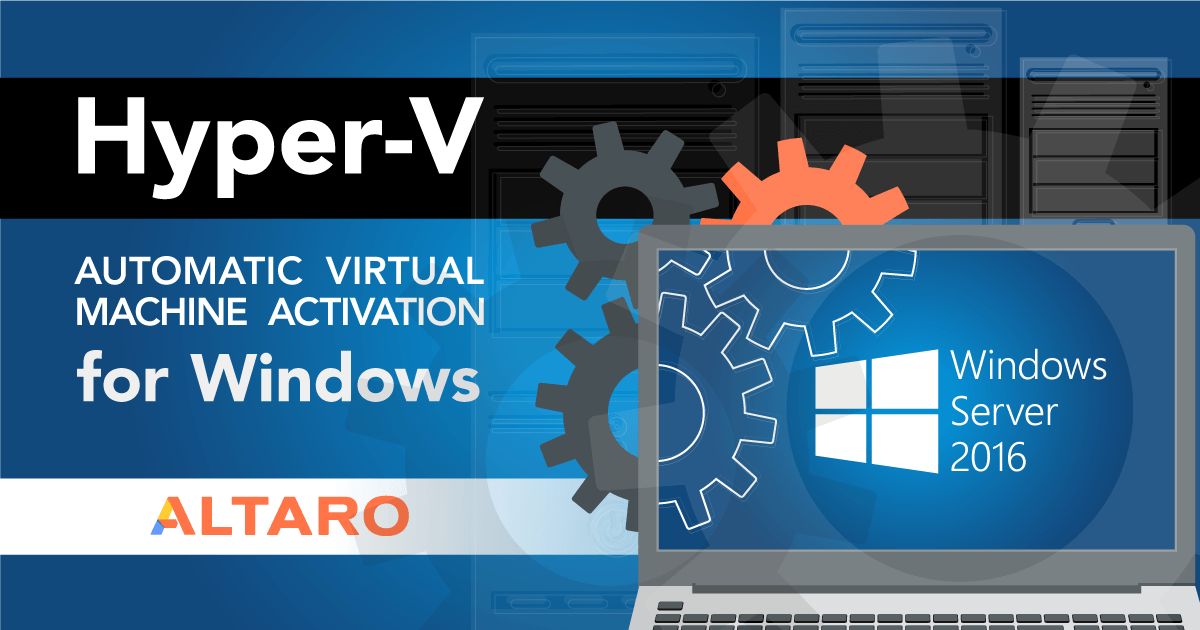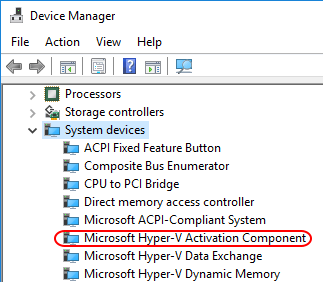Save to My DOJO
Table of contents
- What is Automatic Virtual Machine Activation?
- What are the Requirements for Automatic Virtual Machine Activation?
- Which Guest Operating Systems are Eligible for Automatic Virtual Machine Activation?
- How Does AVMA Work?
- How Do I Configure a Virtual Machine for AVMA?
- How Do Migrations Affect AVMA?
- How Is the Legal Status of Licensing Affected by AVMA and Vice Versa?
Windows Server 2012 R2 introduced a feature called “Automatic Virtual Machine Activation” (AVMA). Based on the number of questions that I’ve seen and fielded about it, I’d say that it’s been quite popular. Windows Server 2016 has carried this feature forward.

What is Automatic Virtual Machine Activation?
Automatic Virtual Machine Activation is a feature that handles the activation process for an instance of Windows Server inside a Hyper-V virtual machine so it does not need to directly contact any other system to activate the Windows Server instance.
AVMA is engineered to digitally facilitate the guest virtualization rights allowance of the Windows Server Datacenter license. If the physical host is properly licensed to run Windows Server Datacenter, then any number of virtual instances running the same or a lower edition and the same or earlier version of Windows Server is included.
[thrive_leads id=’16356′]
What are the Requirements for Automatic Virtual Machine Activation?
You must have a Datacenter Edition of Windows Server 2012 R2 or Windows 2016 installed as the management operating system with the Hyper-V role enabled. AVMA is a feature of the operating system, not Hyper-V itself.
Which Guest Operating Systems are Eligible for Automatic Virtual Machine Activation?
There are a few rules that dictate which guests are covered by AVMA:
- Only Windows Server guests are covered by AVMA. No desktop operating systems are covered by any Windows Server guest virtualization right, so AVMA will not activate them.
- AVMA does not work for guests prior to Windows Server 2012 R2, even though 2008, 2008 R2, and 2012 are still within their support windows and eligible for the guest virtualization rights offered by 2012 R2 and 2016.
- AVMA does not cover Windows Server Foundation 2012 R2 because it is not covered under the Datacenter rights. There is no Foundation edition of Windows Server 2016.
- AVMA in 2012 R2 will not activate any edition of Windows Server 2016.
It might be simpler with tabular data. To keep the table simple, any operating system not shown is not eligible for AVMA:
| Windows Server 2012 R2 will activate |
Windows Server 2016 will activate |
|
|---|---|---|
| Windows Server 2012 R2 Essentials Edition> |
Yes |
Yes |
| Windows Server 2012 R2 Standard Edition |
Yes |
Yes |
| Windows Server 2012 R2 Datacenter Edition |
Yes |
Yes |
| Windows Server 2016 Essentials Edition |
No |
Yes |
| Windows Server 2016 Standard Edition |
No |
Yes |
| Windows Server 2016 Datacenter Edition |
No |
Yes |
How Does AVMA Work?
AVMA is always running on every Windows Server Datacenter installation with Hyper-V; there’s nothing that you need to do. There are several components that work together to facilitate AVMA, and they are all automatic.
- Windows Server Datacenter Edition, as the management operating system, hosts a feature that monitors all virtual machines.
- The Integration Services include a Windows driver that implements most important parts of the guest-side functionality:

AVMA Device
- Virtual machines report their status up to the host via key-value pair exchange. You can use my KVP script set to view this information:

AVMA KVP
The KVP data is only for reporting purposes. Overriding this information on a virtual machine running as a guest on Hyper-V Server or a Standard Edition of Windows Server will not cause a virtual machine to become activated, and any manual modifications will be reset the next time the guest’s KVP service starts.
How Do I Configure a Virtual Machine for AVMA?
There is no true “configuration” for the virtual machine. When prompted for a license key, you simply give it the key that matches the operating system of the virtual machine.
| Guest Operating System | Key |
|---|---|
| Windows Server 2012 R2 Essentials | K2XGM-NMBT3-2R6Q8-WF2FK-P36R2 |
| Windows Server 2012 R2 Standard | DBGBW-NPF86-BJVTX-K3WKJ-MTB6V |
| Windows Server 2012 R2 Datacenter | Y4TGP-NPTV9-HTC2H-7MGQ3-DV4TW |
| Windows Server 2016 Essentials | B4YNW-62DX9-W8V6M-82649-MHBKQ |
| Windows Server 2016 Standard | C3RCX-M6NRP-6CXC9-TW2F2-4RHYD |
| Windows Server 2016 Datacenter | TMJ3Y-NTRTM-FJYXT-T22BY-CWG3J |
These keys will be accepted by any operating system instance with a corresponding version and edition, but if they do not detect the AVMA mechanism, they will transition to unlicensed mode.
[thrive_leads id=’17165′]
How Do Migrations Affect AVMA?
The part of licensing that people seem to struggle the most with is that the virtual machine and its operating system instance are not licensed. Only the host hardware is licensed. If you relocate a virtual machine licensed under AVMA, it must be to a host that is also running Datacenter Edition. Otherwise, the virtual instance will eventually slip into an unlicensed state and begin shutting down every hour. You do have the option to replace the virtual machine’s license key with a non-AVMA key at any time.
How Is the Legal Status of Licensing Affected by AVMA and Vice Versa?
AVMA is simply a technological assistant to deal with licensing. It does not convey any guest virtualization rights that are not legally granted through a legitimate licensing purchase. The inability to use AVMA, such as when using a non-Microsoft hypervisor or Hyper-V Server, does not reduce any guest virtualization rights that you legally acquire with a purchase of the necessary Datacenter licenses. If you cannot use AVMA, you can still use MAK or KMS keys or Active Directory-based activation.


Not a DOJO Member yet?
Join thousands of other IT pros and receive a weekly roundup email with the latest content & updates!









43 thoughts on "Hyper-V Automatic Virtual Machine Activation in Windows Server 2016"
Very helpful. I’m working on a VMware to Hyper-V migration now so this is good to know.
Hi Eric,
I just came across your blog as I’m trying to setup a 2016 server datacenter host with 2 VM guests.
When I look at the system devices from device manager, I do not see the Hyper-V activation component.
Any thoughts?
BTW, I have one server set as datacenter activated and one with a trial version. None of them have the “Hyper-V activation component” listed.
Thanks in advance.
Have you tried the AVMA keys yet? If it activates then I wouldn’t worry about anything else.
Hi There,
I do have server 2016 datacentre Hyper-V and my Gest VMs are server 2012 R2. My Windows 2016 hyper-v is activated with MAC key. buy when i run slmgr /ipk DBGBW-NPF86-BJVTX-K3WKJ-MTB6V on the Guest OS, i get below error: 0xc004e016 On a computer running Microsoft Windows non-core edition.
Any thoughts?
I think you should start by running slui with your full error code on a computer running Microsoft Windows non-core edition to find out what the error message is.
Hi Rafa,
I am dealing with the exact same error code and situation, only using 2012 R2 Datacenter instead of 2016 as my host. Did you get resolution? I haven’t been able to pull up much information with the error code we’ve both seen.
hi,
I have two “server 2012 R2 standard” guest VMs on a “server 2012 R2 standard” hyper-v host.
All were installed from the same OEM server 2012 R2 standard DVD image.
The host has already been activated, successfully.
but, when I logon to either VM guest, I always see “activation required” message on its desktop.
According to Microsoft, server 2012 R2 standard VM guest doesn’t need to be activated….
Is that OK if I just ignore “activation required” message ?
It would be great if somebody gave me an advice.
thanks.
All Microsoft operating systems must be activated. You need to enter a key in the guests. Check with your OEM reseller, start with the sales team, to determine which keys you should use. Support probably doesn’t know.
Dear purpleblue.
I have the same case , Have you found a solution ?
Have you used the same key in the host with guests Vms ?
I have 2012r2 DC activated and new VMs (AVMA activation) will activate only when I do slmgr /ato on them. Machines are configured without persistent disk so each time I restart I have to run slmgr /ato. Shouldn’t be this done automatically?
I have not done what you’re doing so I don’t have direct experience to draw from.
I don’t know how you built up your systems, but is it possible that the VM believes that the hardware has changed since its key was last activated? That would trigger the activation event requirement even if you used an AVMA key.
The closest that I’ve done to what you’re doing is boot new systems that are copied from a sysprep’d base image. They do undergo an activation cycle, but they do so without intervention.
hi Eric,
Quick question.
With the use of Windows Server 2016 build 1709 from Semi-Annual Channel (SAC) running as Hyper-V Host, is it true that the license is covered to run guest VMs with Window Server 2016 (w/GUI) from Long-Term Servicing Channel(LTSC)? My concern is that SAC requires Software Assurance while LTSC doesn’t, so how they work together if that is supported? I just have to continue to license SAC version of Windows Server and that will take care the Guest VMs with LTSC licensing as well?
Thank you,
Remember not to call it “Windows Server 2016 build 1709”. Windows Server 2016 is one thing and Windows Server build 1709 is another.
I do not have an authoritative answer to your question. I would guess that you are correct.
hei,
I have 2 nodes cluster running windows 2012 R2 standard, both fully licensed. I have deployed two windows 2016 standard VMs. How can I activate these? Thanks a lot!
Same way that you would if they were physical.
First off, thank you for this article. It’s very informative.
Are you aware of any caveats when the host is running 2016 Core? I’m unable to get AVMA working and get the error “Error: 0xC004FD02 On a computer running Microsoft Windows non-core edition”. So far Google-foo is not giving much.
0xC004FD02 == “Windows isn’t activated on the host machine.”
Hi
Quick Question: Can AVMA be “daisy chained” with other activation ‘solutions’ ?
For example(s):
1. The Hyper-V host is installed using the 180-days evaluation media (and properly activated)
2. The Hyper-V host itself is activated via KMS or ADBA (it has a KMS client key)
in both examples will AVMA work on guest operating systems installed on said host?
thanks in advance
AVMA always works on an activated Datacenter host. Not sure that I understand what you’re asking.